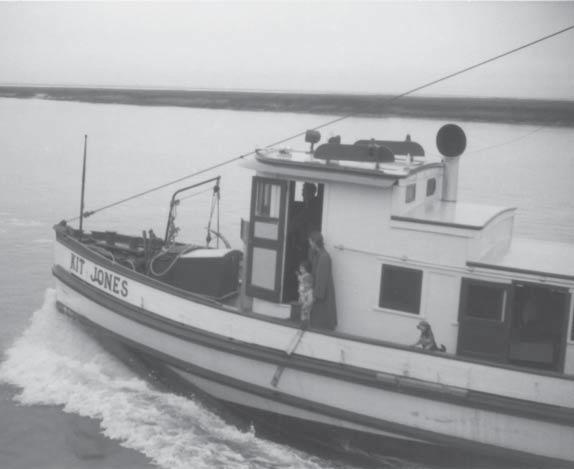
7 minute read
Bringing Home the Kit Jones
By Aimee Gaddis Photos provided by Friends of Kit Jones, Inc.
The Kit Jones often served as a means of transport for island residents.
Advertisement
The Kit Jones is a wood-hull, 60-foot tugboat built on Sapelo island nearly 80 years ago. Friends of Kit Jones (FoKJ), a non-profi t dedicated to preserving this historic vessel, are determined to bring her home.
Origins
Richard J. Reynolds, Jr. commissioned a design from the renowned yacht fi rm Sparkman & Stephens, Inc., of New York City. In 1938-1939, the tugboat was built using heart pine and live oak timbers that were cut and milled on-island. Axel Holger Sparre and Emmett Johnson, Sr. were primarily credited with building the Kit Jones. Sparre was an immigrant living in Brunswick, hailing originally from an aristocratic Danish ship building family, while Johnson was a well-known boat builder from the Johnson Hammock community on Sapelo Island.

The Namesake and the Lady Behind It!
In March of 1939, the vessel was named for, and christened by, Katharine “Kit” Talbott Jones. Kit was the young wife of Alfred W. “Bill” Jones, who had been Island Manager on Sapelo during its ownership by his cousin Howard E. Coffi n. In 1928, at the age of 25, Kit joined her new husband Bill in a move to Sea Island. There, they joined Coffi n in developing the Cloister at Sea Island, which is still managed by the Jones family today. Bill negotiated the sale of Sapelo Island to R.J. Reynolds in 1934 for the cost of $750,000, a price which included $50,000 for Coffi n’s 124-foot luxury power yacht Zapala. Bill and Kit were frequent guests of R.J. Reynolds, Jr. at his new Sapelo Island home, and the naming of this sleek and lovely new tugboat was a natural outgrowth of this friendship.
Sapeloe Plantation, Inc. 1939-1957
The 1940 census for Militia District 1312 (including Blackbeard, Wolf, Egg, Commodore, and Sapelo islands) shows a population of 380. The waterways were a vital means of travel between islands, and the Kit Jones was a vital link in the daily operations of Reynolds’ Sapeloe Plantation, Inc., as well as a primary means of transportation for island residents.
Sapelo native Bennie Johnson was the fi rst captain of the Kit Jones, followed by long-term helmsman Louis “Chief” Olsen, who had previously served as chief engineer of the Zapala. Alongside primary crew member, or “striker” Glasco Bailey, these men skippered the Kit Jones until 1957.
In June 1942, the U.S. War Shipping Administration requisitioned the Kit Jones for service in World War II. She was painted deep red, outfi tted with pumps, and put to work as a U.S. Coast Guard fi re boat based at the Port of Savannah. In October 1946, the boat was decommissioned from government service and returned to ownership of Sapeloe Plantation, Inc.
In early 1957, title to the Kit Jones was transferred to the Universtiy of Georgia. Upon Chief Olsen’s retirement, he turned the ship over to Captain B.J. (Jimmy) Rouse.
UGA Marine Institute 1953-1977
R.J. Reynolds’ service in the U.S. Navy and passion for the sea was the inspiration for his establishment of the Sapelo Island Research Foundation in 1949, which later evolved to become
A 1938 plan drawing of the vessel.
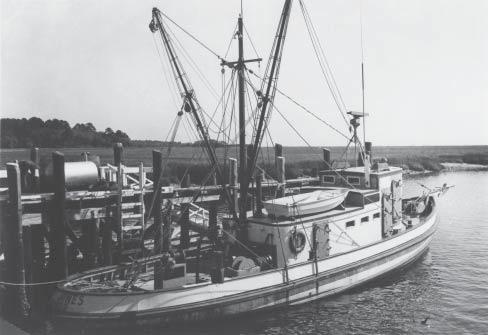
the University of Georgia Athens Marine Institute. The Kit Jones was leased to the newly created foundation in 1953 for scientifi c research and educational programs. In 1957 when her title was transferred permanently to the University of Georgia, her name was extended to Research Vessel (R/V) Kit Jones.
Several grants from the National Science Foundation enabled changes to the vessel to allow for use in deeper water programs of research and exploration, as well as in the nearshore marine environments where she had primarily operated.
The UGA Marine Institute used the R/V Kit Jones as their primary research vessel or over two decades. Jimmy Rouse and James Gault served as captains during this era, with Paul Glenn working often as regular crew. Dr. Eugene Odum, known as the “Father of Modern Ecology,” conducted much of his primary coastal marsh research using the Kit. Other prominent users during these years included Dr. Milton “Sam” Gray, for whom Gray’s Reef National Marine Sanctuary is named, and Dr. Orrin Pilkey, a UGA Marine Institute professor in the mid-1960s, and renowned today for his work in coastline preservation and protection.
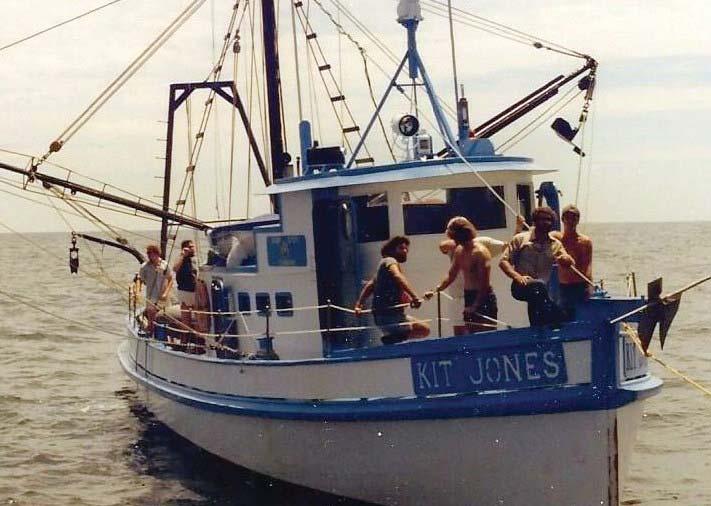
1979, in service for the Skidaway Institute of Oceanography
Skidaway Institute of Oceanography 1977-1982
In April 1977, the R/V Kit Jones was moved from its home port at the UGA Marine Institute on Sapelo Island to the Skidaway Institute of Oceanography (SkIO) on Skidaway Island. Captain Paul Glenn oversaw further updates to the vessel and repurposing for service with new funds for exploration. SkIO remained the home port of the Kit Jones until 1982.
University Of Mississippi 1985 -2016
In 1985, Dr. J. Robert “Bob” Woolsey rediscovered the R/V Kit Jones, having been well-acquainted with her as a graduate student and research assistant at the UGA Marine Institute at Sapelo in the early 1970s. As the director of a new marine research facility on the Gulf Coast, Woolsey learned that the boat was no longer in regular use at SkIO and he brought her to the University of Mississippi as his fl agship vessel.
The R/V Kit Jones operated for almost 30 years out of her home port of Point Cadet, MS, supporting a wide variety of research programs in the Gulf of Mexico. Although capsized and very nearly sunk during Hurricane Katrina in 2005, she ultimately survived to sail again. In June of 2013, the Kit was retired by the University, and pulled from the water a fi nal time. She rests now in drydock at Bay Marine Boat Works in Biloxi, Miss., under the watchful eye of her 30-year caretaker Paul Bodin. There she awaits transport home – back to her origins in McIntosh County, Georgia.
Restoration Plan 2016-2018
On December 15, 2016, the R/V Kit Jones was acquired by the McIntosh Rod and Gun Club, Inc., prompted by the boat's legacy, which is steeped in the historical, cultural, and ecological resources of coastal Georgia and McIntosh County. A non-profi t organization Friends of Kit Jones, Inc. was formed by Davis and Laurie Poole, who now lead a Steering Committee of six, overseeing fi nancial operations and plans for her restoration and preservation. Original blueprints have recently been obtained to guide restoration eff orts.
Through FoKJ, the Kit Jones has received funding from the State of Georgia through Tourist Product Development and Coastal Incentive Grant programs, and some $4,000 has been raised in private individual donations. More fundraising and grant-seeking eff orts are planned or underway. Signifi cantly, the Kit Jones was listed as one of ten 2018 Places in Peril by the Georgia Trust for Historic Preservation, the fi rst vessel ever to receive this recognition.
Plans are underway now for her return trip to McIntosh County! Cost of travel (overland) is estimated at approximately $100 a mile. Supporters are now able to help pay through $100-permile sponsorships for her journey home.

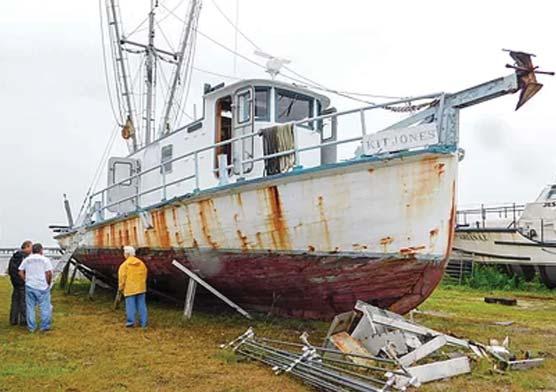
On the hard in Biloxi, Miss., awaiting transport home and restoration.
For further information or to make a donation, visit: www.savethekitjones.com.

Experience the DUNBAR Difference.



Georgia’ Largest Sailboat Dealer Brokerage Services Trade-ins Accepted





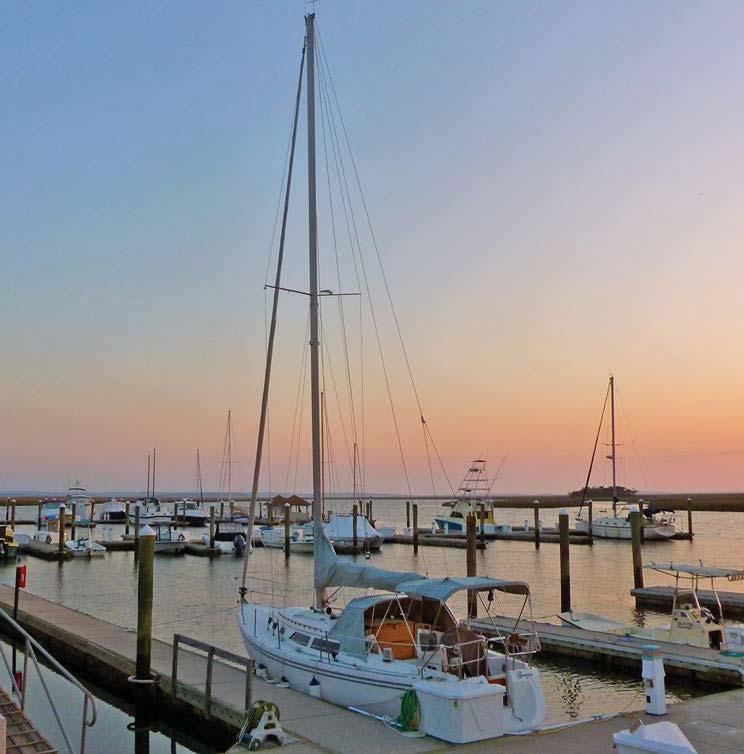

DELEGAL CREEK MARINA Savannah, Georgia
The Landings marinas
Delegal Creek Marina has the guest boater in mind! We are an ideal stopping point for marina guests traveling the Intracoastal Waterway. Located in a protective creek at mile marker 601, Delegal Creek Marina is on the southernmost end of Skidaway Island, offering approximately 500 feet of guest dockage.
Restroom and Shower Facilities • Laundry Ice, Beer and Soft Drinks Fuel • Pumpout Station • Free Wi-Fi Courtesy Golf Cart for Trips to nearby Restaurants, Shops and Grocers • Access to Private Club Restaurants, Facilities and Golf Courses







